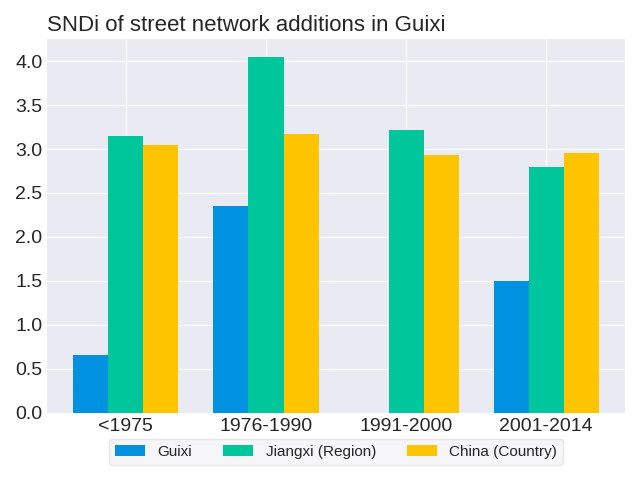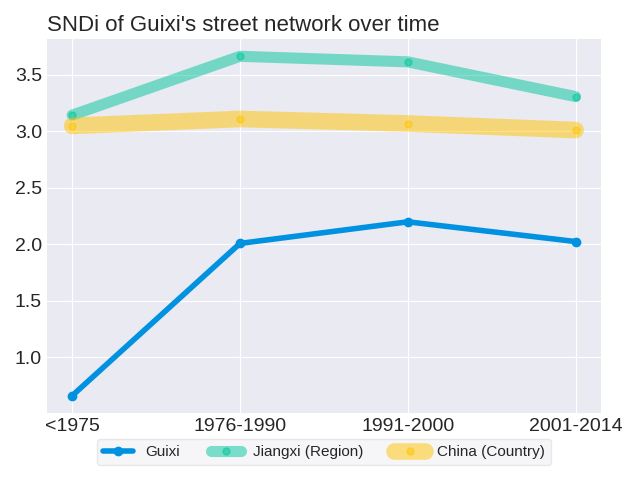Guixi: city in Jiangxi, China


What exactly constitutes the spatial extent of the city? For these aggregations, we used the Global Human Settlement Layer Urban Center Database (GHS-UCDB) to define the boundaries of the city. These cities -- or urban centers -- cover areas that are densely populated and built-up, and so may extend beyond the spatial borders of these cities that we may be familiar with. The GHS area is shaded in blue.
View Guixi, China on the sprawlmap


Most recent snapshot: Taking into account the entire (i.e. aggregate) street network in Guixi as of 2014, the overall level of street-network sprawl is 2.02, which is relatively well-connected.
Trends in street network construction: The SNDis of street construction for the respective time periods are 0.66, 2.35, nan and 1.5. Data was not available in 1991-2000.
Quantity of street network construction: The street network in Guixi spans a total of 134 kilometers. It is dominated by roads constructed in 1976-1990. These roads have an SNDi of 2.35, which is in the 40th to 60th percentile of disconnectedness.
Effect on the aggregate network: New construction in each period adds to the total stock of streets, but does not change streets that have already been built. Therefore, it has a limited effect on the street network as a whole. The SNDis of the aggregate street network in the respective time periods are 0.66, 2.01, 2.2 and 2.02. The aggregate street network in Guixi increased in disconnectivity initially,but the trend has turned around after 2000.

Guixi and Jiangxi do not follow the same trend in the disconnectivity of their street network constructions. There was not enough data from the city, while the SNDi of street constructions in Jiangxi peaked in 1976-1990.
How do development practices in Guixi fare in comparison to others in Jiangxi? Most recently in 2001-2014, street construction in Guixi was the 44th-most disconnected out of the 74 cities in Jiangxi. Its position in the ranks since 1975 has risen; relative to other cities in Jiangxi, street construction in Guixi has become more disconnected. Guixi ranked 50th in 1975, 29th in 1976-1990 and 44th in 2001-2014. There was no ranking in 1991-2000 due to unavailable data.
Guixi and China do not follow the same trend in the disconnectivity of their street network constructions. There was not enough data from the city, while the SNDi of street constructions in China followed a zig-zag trend with an overall decrease.
How do development practices in Guixi fare in comparison to others in China? Most recently in 2001-2014, street construction in Guixi was the 859th-most disconnected out of the 1651 cities in China. Its position in the ranks since 1975 has risen; relative to other cities in China, street construction in Guixi has become more disconnected. Guixi ranked 936th in 1975, 508th in 1976-1990 and 859th in 2001-2014. There was no ranking in 1991-2000 due to unavailable data.

Guixi and Jiangxi do not follow the same trend in the disconnectivity of their aggregate street networks. The SNDi in Guixi peaked in 1991-2000, while the SNDi of street constructions in Jiangxi peaked in 1976-1990.
To date, Guixi is the 37th-most disconnected out of the 74 cities in Jiangxi. Its position in the ranks since 1975 has risen; relative to other cities in Jiangxi, the street network in Guixi has become more disconnected. Guixi ranked 50th in 1975, 35th in 1976-1990, 31st in 1991-2000 and 37th in 2001-2014.
Guixi and China do not follow the same trend in the disconnectivity of their aggregate street networks. The SNDi in Guixi peaked in 1991-2000, while the SNDi of street constructions in China peaked in 1976-1990.
To date, Guixi is the 691st-most disconnected out of the 1651 cities in China. Its position in the ranks since 1975 has risen; relative to other cities in China, the street network in Guixi has become more disconnected. Guixi ranked 936th in 1975, 659th in 1976-1990, 570th in 1991-2000 and 691st in 2001-2014.
As of 2015, Guixi had a built-up area of 14.13 square kilometers, and a population of 113038 people.
These are some other cities with approximately the same population: